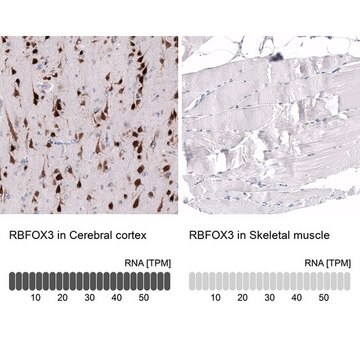ABN51
Anti-NeuN Antibody
rabbit polyclonal
Synonim(y):
RNA binding protein fox-1 homolog 3, Fox-1 homolog C, Hexaribonucleotide-binding protein 3, Neuronal nuclei antigen, NeuN antigen
Wybierz wielkość
1880,00 zł
Przewidywany termin wysyłki21 lutego 2025Szczegóły
Wybierz wielkość
About This Item
1880,00 zł
Przewidywany termin wysyłki21 lutego 2025Szczegóły
Polecane produkty
Nazwa produktu
Anti-Fox-3 Antibody, from rabbit, purified by affinity chromatography
pochodzenie biologiczne
rabbit
Poziom jakości
forma przeciwciała
affinity isolated antibody
rodzaj przeciwciała
primary antibodies
klon
polyclonal
oczyszczone przez
affinity chromatography
reaktywność gatunkowa
mouse, human, rat
metody
immunocytochemistry: suitable
immunohistochemistry: suitable (paraffin)
western blot: suitable
numer dostępu NCBI
numer dostępu UniProt
Warunki transportu
wet ice
docelowa modyfikacja potranslacyjna
unmodified
informacje o genach
human ... RBFOX3(146713)
Opis ogólny
Specyficzność
Immunogen
Zastosowanie
Neuroscience
Developmental Neuroscience
Immunohistochemistry Analysis: A 1:1,000 dilution from a representative lot detected Fox-3 in mouse cerebral cortex, mouse hippocampus, and human cerebellum tissues.
Immunocytochemistry Analysis: A 1:100 dilution from a representative lot detected Fox-3 in E18 rat cortex cells.
Jakość
Western Blot Analysis: 0.5 µg/mL of this antibody detected Fox-3 on 10 µg of mouse e16 brain tissue lysate.
Opis wartości docelowych
Postać fizyczna
Przechowywanie i stabilność
Komentarz do analizy
Mouse e16 brain tissue lysate
Inne uwagi
Oświadczenie o zrzeczeniu się odpowiedzialności
Nie możesz znaleźć właściwego produktu?
Wypróbuj nasz Narzędzie selektora produktów.
polecane
Kod klasy składowania
10 - Combustible liquids
Klasa zagrożenia wodnego (WGK)
WGK 2
Temperatura zapłonu (°F)
Not applicable
Temperatura zapłonu (°C)
Not applicable
Certyfikaty analizy (CoA)
Poszukaj Certyfikaty analizy (CoA), wpisując numer partii/serii produktów. Numery serii i partii można znaleźć na etykiecie produktu po słowach „seria” lub „partia”.
Masz już ten produkt?
Dokumenty związane z niedawno zakupionymi produktami zostały zamieszczone w Bibliotece dokumentów.
Active Filters
Nasz zespół naukowców ma doświadczenie we wszystkich obszarach badań, w tym w naukach przyrodniczych, materiałoznawstwie, syntezie chemicznej, chromatografii, analityce i wielu innych dziedzinach.
Skontaktuj się z zespołem ds. pomocy technicznej








